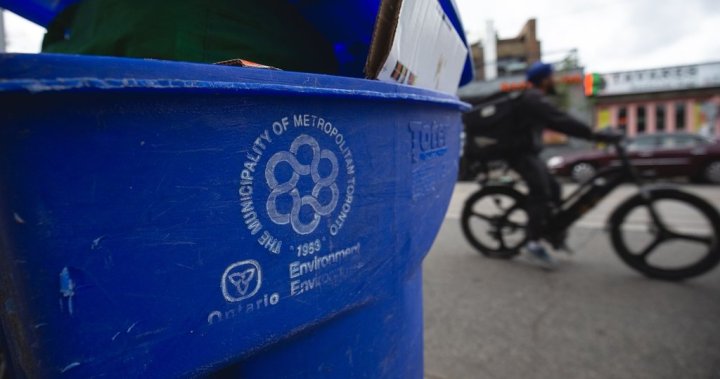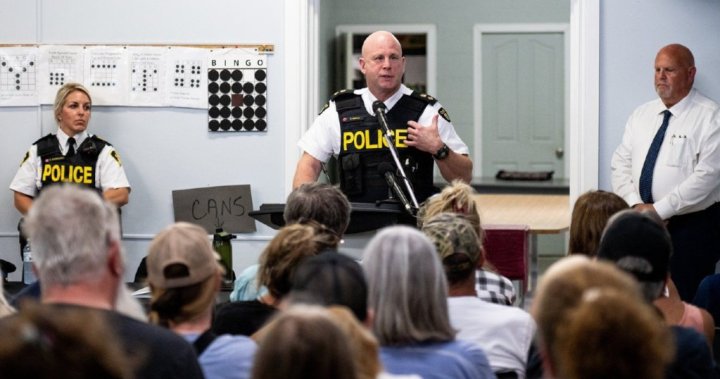Ontario proposes to weaken impending new recycling rules over costs to producers

Ontario Premier Doug Ford’s government is proposing to weaken an impending slate of new recycling rules because producers of the materials said the system is getting too expensive.
The province began transitioning in 2023 toward making producers pay for the recycling of their packaging, paper and single-use items. The companies’ obligations were set to increase next year, but the government is now looking to delay some measures and outright cancel others, such as requirements to extend collection beyond the residential system.
Environmental advocates say the proposed changes let producers off the hook and will mean more materials will end up in landfills or be incinerated. Producers say despite the rising costs, recycling rates don’t actually appear to be improving, so it’s time for a broader rethink.
Environment Minister Todd McCarthy said the proposed changes are about ensuring the sustainability of the blue box system and protecting against unintended consequences such as job losses.
“We want to take what we’ve done and improve upon what already exists, but the costs were a big deal, and so we’re proposing some measures that would bring about cost savings and transparency and improvement to accomplish the goal of recycling that we all want,” he said earlier this month.
The Canadian Retail Council estimates that producer costs have already increased by about 350 per cent in three years and would nearly double again just from this year to next if no changes were made to the impending new rules for 2026.
The government says blue box collection costs could more than double between 2020 and 2030.
“Cost increases of this magnitude were not anticipated when the regulation was passed in 2021 and have jeopardized the stability of the blue box system today,” it says in its proposal to change the rules.
Currently, producers just have to make “best efforts” to hit certain recycling rate percentages, such as 80 per cent of paper and 50 per cent of rigid plastic, and starting next year they are set to be enforceable. Then in 2030 those percentages are set to rise.

Get breaking National news
For news impacting Canada and around the world, sign up for breaking news alerts delivered directly to you when they happen.
But now the government is proposing to delay those 2026 targets to 2031.
As well, Ontario is proposing to allow non-recyclable material that gets incinerated to count for up to 15 per cent of producers’ recycling targets.
Starting next year, producers are also supposed to be responsible for collecting material from more multi-residential buildings, and certain long-term care homes, retirement homes and schools. The government is now proposing to remove that requirement entirely.
The same goes for a rule that would have made beverage producers responsible for containers not just dropped in a residential blue box but also those used outside the home, and a provision for producers to expand collection in public spaces.
The intent behind the initial regulations was to incentivize producers to use less packaging and to use materials that can more easily be recycled, said Karen Wirsig, senior program manager for plastics with Environmental Defence.
These changes would halt any progress on that score, she said.
“Municipalities have been saying for years, ‘Our blue box is getting more and more filled with packaging types we can’t even identify let alone properly sort … because often they’re made with mixed materials that are not easily recycled,’” Wirsig said.
“So because there was that disconnect between the producers who design all this packaging and the municipalities who are collecting it, there was no way to rationalize the system and improve packaging from an environmental and sustainability point of view. These regulations were intended to start doing that, and unfortunately, now all of the incentives are going the opposite direction.”
The recycling of flexible plastics, which includes food wraps, pouches and bags, is a particular bone of contention and the government is proposing to both delay and reduce the target for that category.
In a recycling facility, flexible plastics end up in all sorts of places because they’re so light, getting stuck among paper or falling through the cracks of conveyor belts, said Michael Zabaneh, the Retail Council of Canada’s vice-president of sustainability.
Instead of a recycling target of 25 per cent taking effect next year, a target of five per cent would take effect in 2031 under the government’s proposal for flexible plastics.
That five per cent reflects the estimated current level of flexible plastic diversion, according to the government’s regulatory proposal. It is silent on the current levels for all other materials.
Those current levels are unknown, with the Resource Productivity and Recovery Authority saying it will report on rates once the three-year transition is over. That is a big problem, said Zabaneh.
“We’re all in the blind,” he said. “I think you can’t have a recycling system with accountability, (and not have) transparency and real data.”
The main problem with the government’s current system is that it allows for multiple administrators, said Zabaneh. Producers sign up with producer responsibility organizations, which help them meet their blue box obligations.
There are four such organizations operating in Ontario, which just ends up complicating the system and making it more expensive, Zabaneh said.
“There’s an administrative body to drive collection, but then processing is kind of a competitive thing, and this creates a very fragmented and inefficient system,” he said.
“It limits planning, it prevents collective investment, capital investment, so that’s disincentivized, and you have a lot of added costs from logistics and audits, and that’s why we have escalating costs.”
Retail council members helped found and sit on the board of one producer responsibility organization so they have some idea of recycling rates from that, and based on that limited view the numbers look stagnant, the council says.
Producers welcome the delayed targets, Zabaneh said, but it doesn’t solve the core problem. Having a single producer responsibility organization would reduce costs and allow for greater transparency of recycling rates and financial performance, the retail council says.
Canadian Beverage Association president Krista Scaldwell said their members want the system to be successful because recycling and recovery benefits companies as well as the environment.
“We want the aluminum and plastic back because we can make it into new containers,” she said.
“The members are very committed to sustainability initiatives, and so we need to understand what’s creating the cost so that we can help support some change, so we can see improved recovery without escalating costs.”
Comments on the regulatory registry proposal can be submitted until July 21.


Residents of a tiny rural community in eastern Ontario pressed police on Saturday for answers about a disturbing attack on a young girl that investigators believed was caused by an animal — until they arrested a teenager in the case.
Nearly 100 people filled a small community centre in Quadeville, about 170 kilometres west of Ottawa, for a town hall organized by Ontario Provincial Police to address residents’ questions and concerns about their investigation.
Some have asked why the OPP alerted the community about a suspected animal attack on the eight-year-old girl before announcing two weeks later that a 17-year-old boy had been charged with sexual assault and attempted murder.
Police have said that they never ruled out other possibilities, and that their initial theory was supported by medical and pathology experts.
At Saturday evening’s town hall, police did not divulge any new information about the case that is now before the courts, but sought to assure residents they did everything they could to keep them informed throughout the investigation.
The community centre was packed, with no empty seats to be found. As people filed in, the temperature in the room started to increase on a sweltering evening, especially after someone shut off the portable air conditioning unit that was making noise.
“It’s a very traumatic time for this community because everyone knows everyone involved,” OPP Supt. Derek Needham said at the meeting punctuated by some tense moments.
When police opened the floor for questions, a man who identified himself as a relative of the victim asked why it took a long time for police to respond when the girl was initially reported missing on June 23, after she was last seen at a local store.

Police replied that it took time to bring officers to the scene to search the area.
“I could’ve done my own investigation,” said the man, adding that he lives three hours away.

Get daily National news
Get the day’s top news, political, economic, and current affairs headlines, delivered to your inbox once a day.
The OPP have said that they began their search for the missing child around 9 p.m. on June 23, and found her with life-threatening injuries not long after midnight.
Police asked people to keep their small children indoors amid fears of an animal attack but as their investigation continued, they discovered that there were no traces of animal DNA from the victim’s wounds. Police have not said what kind of evidence led them to arrest the teenage suspect, who cannot be named under the Youth Criminal Justice Act.
Town hall attendee Sandy Musclow asked police how members of the community should interact with the families of the young girl and the suspect.
“A whole lot of healing needs to take place,” Needham said, adding that the best thing for families to do is reach out and have open communication.
After the town hall ended, Musclow said “it’s been a bit difficult to figure out” how to support both families.
“I’ve grown up with them and we really want to make sure that we feel like everyone can feel the pain and move forward together as a community,” she said.

Musclow said that although residents didn’t get much information about the police investigation at the town hall, she was glad to see the community come together. She also pointed to various fundraising efforts for the girl, who remains in hospital, and her family.
“I just feel that the police did a really good job at giving us some solace that they did the right thing for us and they did everything as timely as they could and they were really looking into everyone’s interest,” Musclow said.
OPP spokesperson Bill Dickson told reporters on Saturday that police were compelled to warn the public about a possible animal attack in the early stages of the investigation, even if they weren’t sure that was the case.
“We couldn’t undersell it because if we didn’t say something and warn people and it was an animal and another child was attacked, that would be horrible,” he said.
Dickson said one of the local churches is bringing in counsellors to work with the community and counselling services from the OPP will also be available.
© 2025 The Canadian Press

A new poll by Leger has found that Quebec residents are the happiest in Canada.
The web survey of nearly 40,000 Canadians found that Quebecers rated their happiness at an average of 72.4 out of 100, which is well above the national average.
New Brunswick followed Quebec with an average of 70.2, while Manitoba and Prince Edward Island finished at the bottom of the list.
Mississauga, Ont. had the highest happiness rating of the 10 largest cities, while Toronto was lowest.
Montreal finished second in the category.
The survey found that 49 per cent of respondents said their happiness level was unchanged over the past year, while 23 per said they were happier and 28 per cent said they were less happy.
“These results reveal a population that is both resilient and tested, affected by everyday uncertainty and challenges,” Leger’s executive summary read. “Happiness, while holding its ground overall, shows signs of fragility.”

Get breaking National news
For news impacting Canada and around the world, sign up for breaking news alerts delivered directly to you when they happen.
The survey found that people in the 18-to-24 and 24-to-34-year-old categories were more likely to report improved feelings of well-being, even if their overall happiness score remained below the national average.
In contrast, people in the 35-to-44 and 45-to-54 age brackets were more likely to report their happiness had deteriorated.
“There is a sense of well-being emerging among younger age groups,” the summary read. “However, this also highlights the importance of supporting adults in mid-life, who are more vulnerable to the pressures of working life.”
Quebec, New Brunswick and Newfoundland and Labrador were the three provinces with happiness levels above the national average of 68.7. They were followed, in descending order, by Saskatchewan, Nova Scotia, Alberta, British Columbia, Ontario, Manitoba and P.E.I. The territories were not included in the survey.
In the survey of the 10 largest cities, Mississauga and Montreal finished ahead of Hamilton, Calgary, Brampton, Ottawa, Edmonton, Vancouver, Winnipeg and Toronto, in that order.
Women reported slightly higher happiness levels than men, at 69.4 versus 68.0.
Leger says the overall results confirm “a level of happiness that is relatively high but stagnant or even slightly down compared to the pre-pandemic period.”
To get the results, Leger surveyed 39,841 Canadians aged 18 and up between March 31 and April 13.
Online surveys cannot be assigned a margin of error because they do not randomly sample the population.
© 2025 The Canadian Press

Ontario Provincial Police are set to host a town hall in Quadeville, Ont., this evening to answer questions from residents about an attack on an eight-year-old child that was initially linked to an animal.
Police have arrested a 17-year-old boy in the case and he faces charges of attempted murder and sexual assault with a weapon.
Members of the small community 170 kilometres west of Ottawa say they were in shock after hearing about the arrest and hope to get clarity at today’s event in the town’s community centre.
Local resident Christine Hudder says she wants to know how police came up with the animal attack theory and why families were told for days to keep their children indoors.

Get breaking National news
For news impacting Canada and around the world, sign up for breaking news alerts delivered directly to you when they happen.
The victim was found with life-threatening injuries on June 24 after she was reported missing, and remains in hospital.
Police say they are planning to give as much information as possible to locals given that an investigation is still underway.
-

 Uncategorized1 month ago
Uncategorized1 month agoShop Proud, Eat Proud, Be Proud — Ottawa Canada Day Market This June 28th
-

 4 weeks ago
4 weeks agoCanada’s world junior trial saw juries tossed, intense testimony. Here’s a recap
-

 4 weeks ago
4 weeks agoMeasles circulating in northeastern B.C. community, health officials warn
-

 4 weeks ago
4 weeks agoAnishinabek Nation chief says he briefed Ontario police on protests against Bill 5
-

 4 weeks ago
4 weeks agoRing of Fire road to bring prosperity to First Nation, problems for caribou: report
-

 4 weeks ago
4 weeks agoJagmeet Singh apologizes for attending Kendrick Lamar concert after Drake calls him out
-

 4 weeks ago
4 weeks agoFormer major leaguer, Jays doctor Ron Taylor dies
-

 4 weeks ago
4 weeks agoDreaming of a lakeside cottage but can’t afford it? Co-ownership could open that door







